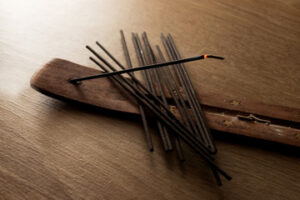A simple form of natural aromatherapy, incense at Psychic helps elevate energy levels in the body and mind. It can also be used as a tool to purify a space.

From fumigating tombs to preparing altars, incense has been a part of ritual and ceremony since ancient times. It comes in stick, cone, or coil forms and can be scented or raw.
When used in conjunction with meditation or prayer, burning incense can help connect us with the framework on which everything is built. It can also evoke a feeling of stability and balance, allowing our minds to settle and clear. Certain fragrances, such as rose or mogra, are known to promote emotional healing and balance, while others, like sandalwood, can offer a sense of spiritual well-being.
There are several different ways to burn incense, including stick and pellet incense, frankincense sticks, snuffs, and more. Each has its own advantages, but all must be burned safely to avoid fire hazards. Always place your incense in a fire-safe container and ensure that no flammable objects are nearby.
Stick incense typically takes 30 minutes to an hour to burn down. This makes it a good choice for use during meditation, working, and meetings. Its scent also serves as a gentler timekeeper than the blaring alarm of your phone or clock.
Incense sticks are shaped and decorated into forms that allow them to stand alone or be set in incense burners. These incense burners can be simple and minimalist or intricately detailed, from a cozy little mushroom to epic depictions of Shiva. These incense containers can be a great way to add an artistic touch to your space.
Stick incense is often made with woody plant materials, aromatic herbs, and tree resins that are blended with synthetic perfumes and additives to make the desired fragrance. The result is incense that smells wonderful but can have a negative impact on respiratory health when inhaled. Recent studies by Koo et al. analyzed data from a cross-sectional survey of 346 primary school children and their non-smoking mothers, as well as a lung cancer case-control study involving 189 women and 197 district matched controls. They found that frequent incense burning was associated with chronic cough, sputum production, and wheezing in children, but not with asthma, allergic rhinitis, or lung cancer in adults.
Fragrance
Aromatic plant materials, frequently coupled with essential oils and other additives make up incense. The fragrance of incense is often associated with spirituality, and it has the ability to trigger a range of emotional responses in people.
The olfactory senses are directly linked to the limbic system of the brain, and different scents trigger a range of emotions and memories in individuals. In the past, woody plants and aromatic tree resins were used for incense, but today’s commercial incense market is full of synthetic perfumes derived from unsustainable plant harvesting practices and harmful chemicals that can have long term health impacts.
Incense fragrances are used for a variety of purposes, depending on the mood and occasion. A soft scent, such as pandan leaves or chamomile can calm the mind and promote relaxation. Frankincense has been found to help reduce anxiety and depression, so it is great for use during meditation. Sandalwood is another calming incense, and it is often used during religious or spiritual ceremonies to create a peaceful environment.
Incense is also a great choice for creating an inviting atmosphere for parties or celebrations. The scent is less intrusive than music and can be a great way to set the mood and encourage conversation among guests. Alternatively, incense can be used to help combat insomnia by releasing soothing scents such as lavender or Vetiver into the air.
There are many different styles of incense available, from traditional sticks to cones and wands. Some of the most popular are sandalwood, frankincense and patchouli. In addition to its mood enhancing properties, frankincense is said to clear the sinuses and relieve congestion. It is also used in moxibustion, a Chinese therapy that involves burning mugwort to treat pain and tension.
Smoke
Many incense users like the aroma of burning incense, but not all like the way the smoke lingers on their furniture, curtains and carpet. The smell of smoke lingering in fabrics can be easily removed by sprinkling a little baking soda on the odor-causing area and vacuuming a few hours later.
In general, the scent of incense is meant to add a pleasant aroma to your home rather than to mask unwanted smells. It’s also a popular practice among religious people to use incense for spiritual reasons and to create a sense of peace and calm. But there are some health risks associated with certain types of incense, particularly those made with synthetic fragrances or low-quality plant materials.
There is no official risk attributed to the inhalation of incense smoke, although some studies have linked it to respiratory problems. In one study, a group of 123 families with children who had leukemia was interviewed about their home environment and smoking habits. They also were asked about the frequency of incense-burning and other air pollutants in their homes. The researchers found that the incense smokers were at higher risk for leukemia than were those who did not burn incense.
The best incense is often made with plant materials such as frankincense, sandalwood and rose. These plants produce natural oils that create a wonderful scent when burned. You can choose from a variety of incense sticks and cones. The stick-shaped incense burns for a longer period of time and produces more smoke than does the cone-shaped incense.
Choosing the right incense is highly personal. It’s a good idea to experiment with several fragrances to see which ones appeal to you and fit your needs. For example, soothing lavender or vetiver incense can help relieve anxiety and promote sleep. A more spirited frankincense scent can enhance meditation or heighten sexual desire.
Pellets
There are many ways to make incense, and different recipes yield very unique aromas. Many resins come in a pliable form allowing them to be molded into pea sized pellets called “incense sticks.” These pellets can then be binded together with other ingredients such as wood chips, leaves, herbs, flowers and spices to create a bundled incense stick that is then heated in an incense burner or makko.
Incense sticks are often made with ingredients such as sandalwood, rose, frankincense and cinnamon and can be found at many retailers. They are a great option if you are looking to add an aromatic element to your meditation or yoga practice or to simply freshen the air in your home. Incense is also known to be filled with antibacterial, insecticidal and fungicidal properties, making it the perfect way to clean your environment.
Burning incense is an ancient practice that has become increasingly popular, especially as people seek to de-stress and find balance in their lives. The pleasant smell of burning incense helps to calm the mind, and it has been proven that certain types of incense can help you fall asleep and sleep better at night.
To light incense, simply hold a lighter or match to the end of the cone and wait for 15 to 30 seconds for it to catch fire. After the tip of the incense has burned, blow out the flame and let it smolder. To change the scent, simply remove the incense from the burner and allow it to cool before adding a new piece.
Making
Incense is used for many reasons – to deodorize, to induce sleep or relaxation, to encourage concentration or motivation and even to stimulate sexual desire. It’s important to use quality ingredients for these purposes. But burning lower-quality incense can actually pollute your home and environment with toxic vapors.
The best way to avoid this is to make your own incense. It’s easy, inexpensive and very satisfying. The basic ingredients are dried herbs and a binder. The herbs are what gives the incense its scent, and the binder is what holds everything together. The best binder is makko powder, made from the bark of the Machillus tree (or agarbatti) but you can also use cedar wood powder or sandalwood powder in its place.
Add the makko to the herbs and mix and blend the two with your hands – almost like kneading dough. When the mixture is of a dough-like texture, you’re ready to start shaping it into cones. Cones are a great incense form because they billow out smoke and bring in a lot of cleansing energy into the space.
Once you have your cones shaped, use twine to keep them in place. Unravel a long piece of twine about five to eight times as long as your bundle and tie it around the stem-side of your incense. Then, tie the twine downward around your bundle and continue wrapping until you’ve reached the top of your incense.
Gum binders are more powerful than wood binders, so be careful not to over-use them. Too much gum binder will make your incense too hard to burn, and it won’t release its scented components at all. Wood binders, such as joss powder or tabu no ki, are more forgiving than gum binders and work well for new incense makers.
